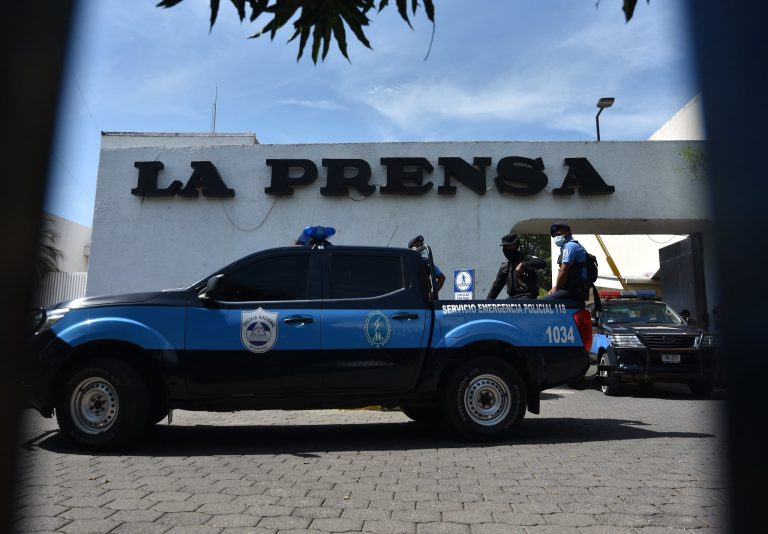17 de agosto 2021

Nicaragua: Public Employees Hindered from Traveling to USA

PUBLICIDAD 1M
PUBLICIDAD 4D
PUBLICIDAD 5D
This threat is destined to fail, because they can never confiscate independent journalism

Las instalaciones del diario La Prensa fueron tomadas por la Policía el 13 de agosto de 2021. Foto: Confidencial
At noon, on Friday, August 13, President Daniel Ortega, the Sandinista candidate for reelection and Supreme Head of the police, ordered a police assault on the installations of the newspaper La Prensa.
That same night, Ortega justified the attack in a speech to the Nicaraguan Naval forces. Offering no evidence, he alleged that La Prensa had engaged in Customs’ fraud and money laundering. Clothing himself in judges’ robes, he issued an advance verdict of “guilty”. “Slandering the government is a crime,” threatened the ruler, who has become the jailer of any and all Nicaraguans.
The truth is in full public view, and no government lie can hide it. For over 500 days, starting in 2018, the regime’s Customs office imposed a blockade on La Prensa, paralyzing their imports in an act of administrative censorship. The blockade was temporarily lifted in February 2021, thanks to the mediation of Apostolic Nuncio Waldemar Sommertag. However, it was reestablished in recent weeks, and La Prensa was once again kept from accessing its imports of newsprint. When the existing inventories ran out on Friday, August 13, the government had essentially forced the closure of Nicaragua’s last print newspaper.
The raid on the paper’s installations followed La Prensa’s announcement of the suspension of their print edition. Immediately afterwards - in the early hours of Saturday - the newspaper’s manager, Juan Lorenzo Holmann, was abducted by the police, and the government announced that the police and Public Prosecutor had opened an investigation.
The objective in all this was to close down an independent media outlet and impose censorship. Indeed, they succeeded for several hours, by disconnecting the servers for the newspaper’s website. Nonetheless, beginning the night of that same Friday, La Prensa has continued informing on its digital platform, just as we’ve done at Confidencial, and at 100% Noticias since December 2018, when the police illegally invaded and occupied our newsrooms. In February of this year, the government consummated their confiscation of the latter two installations, in a move that’s totally unconstitutional.
That same threat hangs over La Prensa today. It’s a threat that’s destined to fail, because they’ll never be able to confiscate independent journalism. The media newsrooms don’t lie within the four walls of an office, but in the independent journalists’ convictions and commitment to the truth.
La Prensa’s resilience lies in their democratic values that have allowed them to survive the most rabid attacks of authoritarian power. On January 10, 1978, the Somoza dictatorship’s thugs assassinated my father, Pedro Joaquin Chamorro, then La Prensa’s director. He had modernized national journalism and raised up the Paper Republic. They assassinated him, but they could never kill his ideas.
A year and a half later, during the final insurrection of 1979, in an act of vengeance, Somoza ordered the National Guard to attack the installations of La Prensa with airplanes and tanks, until the installations were completely destroyed. Poet Pablo Antonio Cuadra, at that time director of La Prensa, described that brutal attack to the newspaper El Pais: “It’s a complement to the death of Pedro Joaquin Chamorro. First, death; later, destruction. It symbolizes the dictatorship’s horror of ideas, of people who think of free expression.”
Now, forty-two years later, our new dictatorship’s fear of a free press and free elections has coalesced in the takeover of La Prensa, under a different pretext, but with the same aim of trying to silence an independent news source.
By assaulting La Prensa, Ortega and Murillo are trying to smash the democratic credo of Pedro Joaquin Chamorro, the last reserve of freedom, in order to clear the road of obstacles in their plan to impose a totalitarian dynasty on Nicaragua. Like Somoza, they want to finish off the Paper Republic, which today is also a Digital Republic, as my uncle Jaime Chamorro Cardenal, recently deceased, warned last year during the 94th anniversary of La Prensa, which he then directed.
Because of that, even under police occupation, La Prensa will continue producing journalism as a symbol of freedom while Ortega and Murillo already form part of the past, of dictatorship and corruption.
The Somoza dictatorship was defeated by a popular insurrection in July 1979, and La Prensa rose out of the ashes. In 2022, after Ortega and Murillo are reelected with no competition and no legitimacy, this XXI century dictatorship may prolong their agony for a time, but always at the cost of aggravating their own crisis. All of the living forces in the country know this, especially the public employees, both civilian and military, who also have no future with the regime.
Meanwhile, the independent press will prevail, and go on to tell the story of Ortega and Murillo’s departure from power. The great desire of my father, Pedro Joaquin Chamorro, that “Nicaragua will once again be a Republic,” is more relevant today than ever. It will be the reconstruction banner of the new Nicaragua, in democracy, with justice and without impunity.
This article was originally published in Spanish in Confidencial and translated by Havana Times
Archivado como:
PUBLICIDAD 3M
Periodista nicaragüense, exiliado en Costa Rica. Fundador y director de Confidencial y Esta Semana. Miembro del Consejo Rector de la Fundación Gabo. Ha sido Knight Fellow en la Universidad de Stanford (1997-1998) y profesor visitante en la Maestría de Periodismo de la Universidad de Berkeley, California (1998-1999). En mayo 2009, obtuvo el Premio a la Libertad de Expresión en Iberoamérica, de Casa América Cataluña (España). En octubre de 2010 recibió el Premio Maria Moors Cabot de la Escuela de Periodismo de la Universidad de Columbia en Nueva York. En 2021 obtuvo el Premio Ortega y Gasset por su trayectoria periodística.
PUBLICIDAD 3D